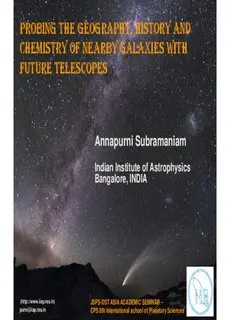
Galactic Astronomy PDF
Preview Galactic Astronomy
Probing the geography, history and chemistry of nearby Galaxies with Future Telescopes Annapurni Subramaniam Indian Institute of Astrophysics Bangalore, INDIA (http://www.iiap.res.in) JSPS-DST ASIA ACADEMIC SEMINAR – [email protected] CPS 8th International school of Planetary Sciences Galactic Astronomy • Content – Stars – Gas, Dust • Structure & Kinematics • Dynamics & Ecology • Formation & Evolution – Star formation – Chemical evolution – Dynamic evolution – Interaction with neighbours • Galactic Centre Galactic Structure (105 – 106 stars) Harlow Shapley (1920s): Size from globular clusters Halo is metal poor and > 10 billion years old Galactic Disk • Stars – Single – Binary – multiple – Associations – Open Clusters • A few 100 stars – less than a few billion year old – Metal rich Galactic Disk • Gas and dust – Diffuse – Clouds of different density and size • Globules (~1 M ) • …. • Giant Molecular Clouds (~106M ) – Absorbing – Polarizing – Reflecting – Ionized – Emitting in the IR Galactic Disk: Ecology Leads to Chemical Enrichment Multiwavelength View • Infrared • Emission from warm dust, hot dust, stars • Radio • 21 cm H I line • Synchrotron radiation from charged particles in magnetic field •X-rays and gamma- rays • supernova remnants • Pulsars • starforming regions
